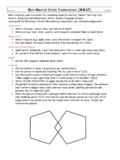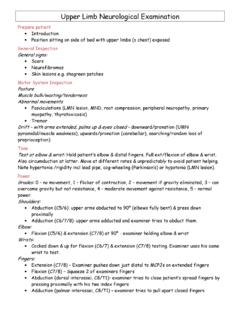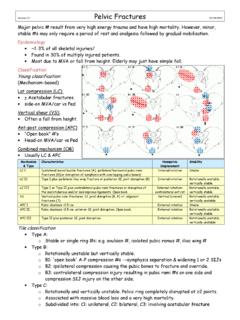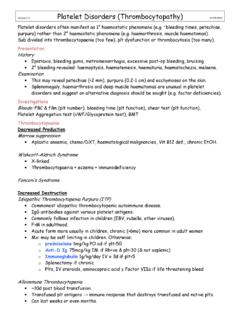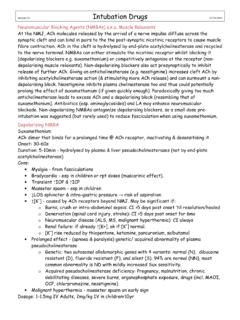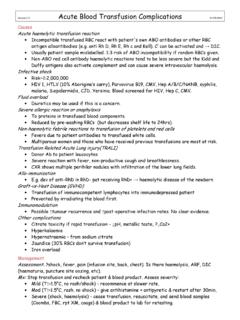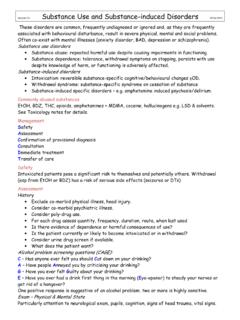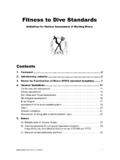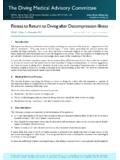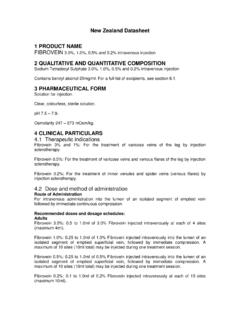Transcription of Cerebrovascular Accident (Stroke) - ambonsall.com
1 Version Cerebrovascular Accident (Stroke) 5/05/2012 Clinical syndrome, of presumed vascular origin, with acute signs of focal or global cerebral dysfunction lasting >24 hours or leading to death. May be ischaemic cerebral infarction (~85%) or intracerebral haemorrhage (10% ICH & 5% SAH). Causes Thrombosis in/situ. Athero/thromboembolism ( from carotid or vertebral arteries). Heart emboli (atrial fibrillation, infective endocarditis, myocardial infarction). Central nervous system bleed (hypertension, head injury, aneurysm rupture). Sudden blood pressure drop by more than 40mmHg.
2 Subclavian steal. Vasculitis, giant cell arteritis. Venous/sinus thrombosis. Hyperviscosity syndromes. In a young patient, consider: vasculitis, thrombophilia, SAH, venous/sinus thrombosis or carotid artery dissection ( via near/strangling or fibromuscular dysplasia). Epidemiology In UK annual incidence is , rising rapidly with age to 10/1000 at age 75 years. Risk Factors Male Family history Past TIA in ~15% of ischaemic strokes Hypertension Smoking Diabetes Mellitus Heart dis.( valve, ischaemic, AF, PFO, IE) Hyperlipidaemia COCP Peripheral vascular disease Polycythaemia vera Coagulopathy Carotid artery occlusion Excess alcohol Presentation Onset may be sudden or a step/wise progression of symptoms and signs over hours/days.
3 Clinical course may help to differentiate stroke subtypes: o ICH doesn t improve in the early period; it progresses gradually during mins/hrs o Embolic strokes most often occur suddenly. Rapid recovery also favours embolism. o Thrombosis/related symptoms often fluctuate, varying between normal and abnormal or progressing in a stepwise fashion with some periods of improvement. o Lacunar (penetrating artery) infarcts usually develop over hours or at most a few days, compared with large artery/related brain ischemia, which can take longer. o Aneurysmal SAH develops in an instant.
4 Focal brain dysfunction is less common. The two types of stroke are not reliably distinguishable clinically but pointers include: o Haemorrhagic: onset seizure, meningism, N&V, sev headache and coma within hours o Ischaemic: carotid bruit, atrial fibrillation, past TIA Focal signs relate to distribution of the affected artery, but collateral supplies may cause variation in the presentation. (See also table below) o Cerebral hemisphere infarcts (50%) usually embolic o Brainstem infarction (25%) o Lacunar infarcts (25%) / usually thrombotic Cerebral Infarction Syndromes Symptoms and Signs Anterior cerebral artery (uncommon) Contralateral hemiparesis (maximal in the leg), urinary incontinence, apathy, confusion, poor judgment, mutism, grasp reflex, gait apraxia Middle cerebral artery (common) Contralateral hemiparesis (worse in the arm and face than in the leg)
5 , dysarthria, hemianesthesia, contralateral homonymous hemianopia with ipsilat gaze preference, aphasia (if the dominant hemisphere is affected) or apraxia and sensory neglect (if nondominant hemisphere) Posterior cerebral artery Contralateral homonymous hemianopia, unilateral cortical blindness, memory loss, ipsilateral 3rd cranial nerve palsy, hemiballismus Ophthalmic artery (branch of MCA) Monocular loss of vision (amaurosis) Vertebrobasilar system (Cerebellar and brainstem lesions) Subtype: Lateral medullary syndrome: (Wallenberg syndrome / PICA) Unilateral or bilateral cranial nerve deficits ( nystagmus, vertigo, dysphagia, dysarthria, diplopia, blindness), internuclear ophthalmoplegia, truncal or limb ataxia, spastic paresis, crossed sensory and motor deficits*, impaired consciousness, coma, death (if basilar artery occlusion is complete), tachycardia, labile BP, locked/in syndrome.
6 Ipsilateral motor VIIn, IXn, Xn, ipsilateral Horner s, hiccups, contralateral pain & temperature (spinothalamic) loss to body (ipsilateral to face), conjugate gaze palsy. Occasionally also from PICA as well as vertebral artery. Lacunar infarcts (Small infarcts in distribution of short penetrating arterioles of basal ganglia, thalamus, pons, cerebellum, internal capsule, deep white matter. Account for 15/20% cerebral infarcts. Assoc with poorly controlled DM & HT. Aspirin less effective, but good prognosis.) Absence of cortical deficits (aphasia, visual loss) plus one of the following: o Isolated unilateral ataxia, o Isolated unilateral dystonia o Isolated unilateral Parkinsonian signs o Isolated hemiparesis o Isolated unilateral sensory deficits o Isolated dysarthria o Unilateral ataxia plus hemiparesis o Dysarthria plus hemiparesis, esp of the face, tongue, and hand *Ipsilateral facial sensory loss or motor weakness with contralateral body hemianesthesia or hemiparesis indicates a lesion at the pons or medulla.
7 Intracerebral Haemorrhages Features Lobar haemorrhages Rapid onset, focal headache over bleeding area Putamenal haemorrhages Most common, contralateral eye deviation, contralateral hemiplegia Thalamic haemorrhages Contralateral hemiplegia, eyes down & in, unequal pupils, absent light reflex, ipsilat Horner s, lateral gaze defects, sensory deficit, aphasia Pontine haemorrhages Deep coma + quadriplegia, pin/point pupils, decerebrate, hyperpnoea, HT, hyperhydrosis Cerebellar haemorrhages Develops over hours, repeated vomiting & vertigo, contralateral eye deviation, no paralysis Examination Includes full neurological exam, CVS exam (?)
8 AF, BP, pulses), fundoscopy for hypertensive retinopathy. Look for risk factor signs arcus senilis, plethora of polycythaemia. Differential Diagnosis CNS tumour Subdural bleed Todd's palsy Consider drug overdose if comatose. Initial Rapid Assessment / NICS Emergency Dept Stroke & TIA Care Bundle 1. Rapid initial stroke screen: ROSIER (93% sens, 83% spec): LOC or syncope /1 Seizure /1 New acute onset of: Asymmetric facial weakness +1 Asymmetric arm weakness +1 Asymmetric leg weakness +1 Speech disturbance +1 Visual field defect +1 Score 0 stroke unlikely Also includes recording the: GCS BP BSL Or NIH Stroke Scale (used in trials, simplified for ED as Cincinatti Prehospital Stroke Scale) Total Score: 0 = no stroke 1!
9 4 = mild stroke 5!15 = mod stroke 15!20 = mod!sev stroke >20 = severe stroke 2. ABCD2 assessment if TIA suspected: 3. Urgent CT or MRI Stroke or High risk TIA: ASAP <24hr, ideally within 30mins Low risk TIA: <72hr +// a carotid USS (where indicated) 4. Nil by mouth until bedside swallow screen (within 24 hours) for stroke 5. Aspirin 150/300mg PO as soon as possible (<48hr) if haemorrhage excluded 6. Physiological monitoring and management: Neurological status regular monitoring GCS BSL cautiously treat marked hyperglycaemia. Avoid hypoglycaemia BP cautiously lower by 10/20% if 220/120mmHg or MAP 130.
10 Avoid hypoBP Hydration status maintain euvolaemia Investigations Bloods: FBC, ESR, UEC, BSL, lipids, coags, CK/Trp, ABG. Occ sickle cell disease or syphilis tests. ECG: Arrhythmias, MI Imaging: CXR aortic dissection, aspiration, cardiac chamber enlargement, intrathoracic Ca CT scan: o Immediate scan used: Rule out haemorrhage where thrombolysis or anticoagulation indicated ICH/SAH suspected: known bleeding tendency, on anticoagulants, unexplained progressive or fluctuating symptoms, severe headache at onset DDx: depressed LOC, papilloedema, neck stiffness or fever o 50% infarcts detectable <6hrs (init signs.)
